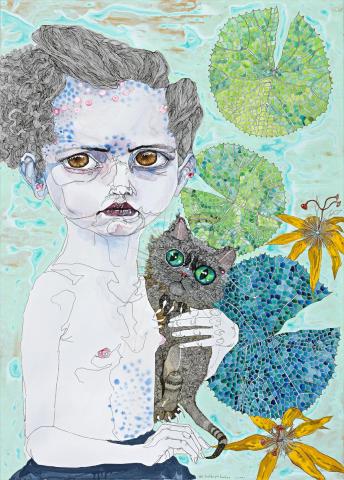GIRL #9, 2004
DEL KATHRYN BARTON
synthetic polymer paint, gouache, watercolour and ink on polyester canvas
120.0 x 86.0 cm
signed and dated lower centre: del kathryn barton – 2004 –
signed, dated and inscribed verso: “girl #9” del kathryn barton 2004
Ray Hughes Gallery, Sydney
Company collection, Sydney
Del Kathryn Barton, Girl, Ray Hughes Gallery, Sydney, 2004, cat. 9
Ewington, J., Del Kathryn Barton, Piper Press, Sydney, 2014, p. [14] (illus.)
Awarded the prestigious Archibald Prize in 2008 for You are what is most beautiful about me, a tender self-portrait with her two children Kell and Arella, and again in 2013 for her pensive portrayal of actor Hugo Weaving, Del Kathryn Barton is undoubtedly one of the most critically acclaimed, eagerly sought-after figures in Australian contemporary art. Betraying a myriad of artistic influences from the fine nude drawings of Egon Schiele to the eroticised poupées of Surrealist Hans Bellmer, her richly illustrative work offers a complex, often disorienting meditation upon the dichotomous nature of beauty which, by highlighting both its sensual and abject dimensions, seeks to undermine simplistic notions of the feminine. Not surprisingly perhaps, Barton also references the contradictions inherent in society's celebration of female beauty through the shallow space of fashion - its collapse of life into a pose and collapse of character into a decorative appearance. For all their contemporary allusions however, Barton's lithe figures also seem strangely of another time - their big, overstated eyes recalling the feminine vapid, doe-eyed cuteness in post-war Japanese manga or the unearthly gaze often found in naive art.1
Painstaking in its embellishment, girl #9, 2004 not only indulges Barton's fascination with the world of children, but continues her enduring preoccupation with the female face as a repository of thoughts, emotions and fantasies. Occupying an enchanted realm adorned with flourishes of foliage and wildly chaotic patterns, the work betrays a compulsive beauty in its infinitely rendered elaboration. Yet if alluding to the imaginary, naive world of children, at the same time the direct, steady gaze of the sitter implies a certain knowingness or wisdom - what does she reveal with her overblown face and simultaneously conceal with her innocent stare? Like the protagonists punctuating countless fairy tales and mythological stories in Western art and literature, indeed Barton's ethereal sprites are already adult, expressive and sexually empowered. That the present sitter embodies a wealth of human desires, repressions and fears is eloquently reiterated here by the feline companion which she guards. Continuing the artist's abiding concern with the effect of nature upon humankind's physiological and metaphysical existence, the animal poignantly evokes the duality of the human psyche and the seemingly impenetrable mysteries which it holds - what seems cute and benign may also be carnal and predatory.
Appealing to the basic human impulse to imagine the character behind a face, thus girl #9, 2004 both delights and beguiles in its disconcerting fluidity between real and imaginary, representation and subjectivity. As Julie Ewington observes in her recent, sumptuous monograph on the artist, 'Everything in these mythic universes is already significant, though not always to the uninitiated ... it is as if the paintings are manifestations of a narrative which one must not only learn, but earn.'2
1. Colless, E.,'Del Kathryn Barton', Australian Art Collector, vol. 38, Oct-Dec 2006, p. 130
2. Ewington, J., Del Kathryn Barton, Piper Press, New South Wales, 2014, p. 53
VERONICA ANGELATOS
